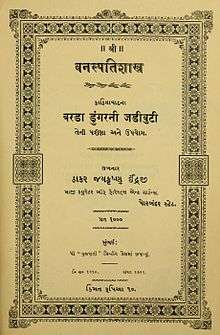Jayakrishna Indraji
Jayakrishna Indraji (sometimes spelled Jaikrishna or referred to as Jayakrishna Indraji Thaker) (1 October 1849 – 3 December 1929) was an Indian botanist and ethno-botanist from the Princely state of Porbander who wrote the first botanical treatise[1] in an Indian regional language (Gujarati) - Vanaspati Shastra (1910).
Life and work

Jayakrishna Indraji was born on Vijayadasami day (Samvat 1905[2]) 1849 in Lakhpat village, Kutch. He came from a family of temple priests and he was the fourth of five sons and two daughters. Following the death of his father, he lived with an older brother and worked for some time as a helper cook for a priestess at a temple in Sindh (now in Pakistan). At 14 he moved to Bombay to stay with another brother to study at high school but he could not pay the monthly fee of a rupee and abandoned studies. He briefly moved to Mathura with another brother to run a book business but this closed down. Ill health forced his return to Bombay where he was treated by Bhagwan Lal Indraji, an archaeologist and specialist in Ayurveda. This sparked an interest in herbal medicine and plants and became interested in traditional herbal medicine. He began to study Hooker's First Book of Botany and learned to prepare herbarium specimens. Bhagwan Lal then suggested that Indraji meet Dr Sakharam Arjun, botany professor at Grant Medical College. He began to identify plants and learn botany from Sakharam Arjun and preparing herbarium specimens of plants from around Bombay. He gradually became acquainted with many other naturalists including Herbert Mills Birdwood, Chester MacNaghten, Principal of the Rajkumar College at Rajkot, James Macnabb Campbell and Dr MacDonald who succeeded Dr Sakharam Arjun at the Grant Medical College. When MacNaghten went on holidays he sought the ethno-botanical assistance of Indraji and along with Dr MacDonald, they made visits to Matheran to study the flora.[3] Rustomjee Khory made use of Indraji's assistance while producing his Materia Medica but made no acknowledgement.[4][5]
Herbert Mills Birdwood and MacNaghten attempted to help Indraji obtain a suitable employment but Indraji would not accept working with anyone but Bhagwan Lal. Through MacNaghten, the Maharaja of Porbander offered assistance for Indraji to study the flora of the Barda mountain. Frederick Styles Philpin Lely, who was the British administrator for Porbander also supported the project and Indraji was appointed as Curator of Forests and Gardens of the state of Porbander on 1 October 1886. Initially Indraji declined the offer as the salary was Rupees 100 a month but on the influence of MacNaghten and Lely this was increased to 200 and he took the offer. Jayakrishna worked with the local shepherd community, the Rabaris, to collect ethnobotanical information. One of his studies was on the lethal effects of Indigofera cordifolia on sheep that grazed them shortly after the rains.[6] He worked for 19 years in the region and produced his magnum opus, on the Flora of Barda Mountain only in 1910. Although he was persuaded to write it in English, he chose to write it in Gujarati and titled it "Vanaspati Śāstra, A Complete and Comprehensive Account of the Flora of Barda Mountain". He wrote: "Europeans placed in their countries know and write about the plants of this country, and my countrymen would not know about the plants in their courtyard and those trampled under their feet. I will write the book in my mother tongue". When the manuscript of the book was ready, the Maharaja of Porbander had died and there was no monetary support for it. Only a 1000 copies were printed. He retired and moved to Kutch where the Maharaja of Kutch took an interest and made him Superintendent of the Palace and made him in-charge of reforestation and planting. He promoted the use of tree planting to block the expansion of dunes and wrote a book Plants of Kutch and Their Utility (1926) which included 99 line drawings.[5]
Indraji's herbarium collection is partly preserved at the College of Agriculture, Pune.[7]
Indraji married at the age of about 38 and had two sons who died young but a daughter survived. When Jayakrishna died at Bhuj on 3 December 1929, Mahatma Gandhi wrote an obituary commenting that "...He had a vast collection of plants ... such men with unflinching devotion to their interest are rare. Let all of us emulate his single mindedness and self confidence."[5]
References
- ↑ Santapau, H. (1958). History of Botanical Researches in India, Burma and Ceylon. Part II. Systematic Botany of Angiosperms. Bangalore: Bangalore Press. p. 7.
- ↑ "Shri Jayakrishna Indraji Birthday Centenary Celebration". Journal of the Gujarat Research Society. 11 (4): 252–255. 1950.
- ↑ Birdwood, H.M. (1886). "A catalogue of the flora of Matheran". Journal of the Bombay Natural History Society. 1: 203–214.
- ↑ Khory, Rustomjee Naserwanjee (1903). Materia medica of India and their therapeutics. Bombay: Canton Works.
- 1 2 3 Shah, J.J. (2014). "Botanist Jaykrishnabhai: 1849-1929" (PDF). Indian Journal of History of Science. 49 (1): 58–61.
- ↑ Indraji, Jaikrishna (1893). "The Bhakha plant (Indigofera cordifolia) and its effect on cattle". Journal of the Bombay Natural History Society. 8: 444–447.
- ↑ D'Cruz, R.; Santapau, H. (1952). "A note on the Jayakrishna Indraji Thaker collection of plants preserved in the herbarium, Agricultural Colleg, Poona". Poona Agricultural College Magazine. 42: 210–233.